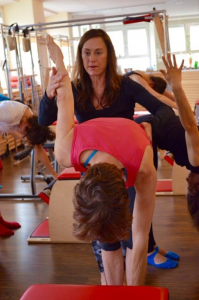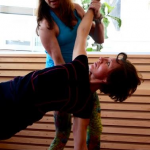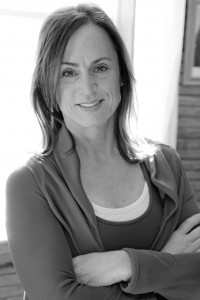Teaching Pilates with Purpose and Power
by Clare Dunphy
Purpose: The reason for which something exists or for which it has been done or made;
The goal or intended outcome of something;
The desire or the resolve necessary to accomplish a goal.
Power: The ability, strength, and capacity to do something.

Learning to be an effective Pilates teacher takes time and practice. For the last three decades, I’ve had the pleasure to observe great teachers in action and the opportunity to mentor teachers on their own journey. Excellent teaching doesn’t happen by accident; it happens on purpose. In my experience, excellence in teaching circles back to two main themes:
- Choosing an approach to teaching Pilates that is based on clarity of intent in both what and why
- Being determined to find solutions to reach the goal of the purpose.
At the end of the day, we all want to be effective and have our efforts make a difference in the people’s lives we touch, right? Here’s a glimpse into what I found that works. I hope you will find a tidbit or two that you can adopt into your teaching.
When a student comes in for a regular lesson, we generally get started on the mat or reformer, unless there is a special reason to work somewhere else. In addition to noticing their movement as they enter the studio, I pay careful attention during the first few exercises to get a sense of where they’re at that day, what looks on or off. And while I might have a plan for their session that day, I stay open to discovering whatever actually happens as the session unfolds. Then I ask myself questions about what I see in front of me.
Here is a sample of initial questions that can each open the doors to the next question, to further probing and to ultimately guiding my cues, touch, and exercise choices:
- What’s the quality of their movement? Quick, slow, tense, free, rigid, with or without awareness of their powerhouse?
- How is their core working? Are they finding their Powerhouse? Are their abdominals in and up with their inner thighs and seat working properly? How do they come into position for the Hundred? Can I see their arms and legs reaching out from their powerhouse?
- Are they breathing deeply? Do they hold their breath? Are they chest breathers?
- Can they articulate their spine from top to bottom and bottom to top in the Roll Up? Can they stabilize their pelvis in the One Leg Circle or Frog and Leg Circles? Can they keep their shoulders away from their ears?
- Are they finding the role of the two-way action in all their movements? Is there a balance in the lower and upper part of their 2-way stretch or is one part weaker?
- Can they keep their Box square? Is there an even length in their waist between the ribs and hips?
- Where do they let go, collapse, rush or go too slow? What’s their slouching habit? Are they avoiding something?
- What is obviously showing up right in front of me? How does working with this person make me feel?
 When I pay attention early in the session and begin asking myself these questions right from the start of the session, the puzzle pieces start to fall into place and it becomes clearer what they need from Pilates that day. I don’t need to figure everything out right away, but I can get off to a good start knowing that the session will reveal more once we get working.
When I pay attention early in the session and begin asking myself these questions right from the start of the session, the puzzle pieces start to fall into place and it becomes clearer what they need from Pilates that day. I don’t need to figure everything out right away, but I can get off to a good start knowing that the session will reveal more once we get working.
If there is tightness in the neck for example, I will look at how they lift their head in the Hundred and provide instructional cues or use tactile assistance specific to that intention. Each time they lift their head throughout the session, the intention will be consistent until that movement pattern improves.
On the other hand, in the Hundred, if they are strong in the upper torso and can raise their head well, properly recruiting their abdominals but their lower body is less organized (I see this in a lot of male athletes) – for example their legs are apart, bottom not actively wrapping and legs not really reaching out through the lower half of their two-way stretch from the lower back – then I know to emphasize the lower part of the two-way stretch as we work through the session. That awareness and little adjustment in my teaching will make the session feel great for them and make sense to their body! Everyone I have ever worked with has a “thinking body”. The apparatus and the exercises are “helpers” to get students to feel what they need to do and how they need to work in their body. The ultimate goal of course, is mastery of the mat.
During a session, by the time I get through the mat and/or reformer, depending on the person, I now have enough puzzle pieces to pick exercises specifically geared to address what my student needs that day. We have many tools (chairs, barrels, Cadillac, pedi-pole, foot corrector, etc.) to help our students improve a weak area and challenge strong areas too! The art of teaching is learning how to use the apparatus to help the student make new connections that carry over to the mat work, sports performance, and daily life. Our job is to let the apparatus help us to help our students make the connections they need to achieve balance and learn to move in healthy ways. We can’t really teach someone Pilates, we can only guide them toward their own self-discovery. The more I practice, learn and teach, the more I realize how brilliant this work really is. It is amazing and endless. Cheers to your journey!


